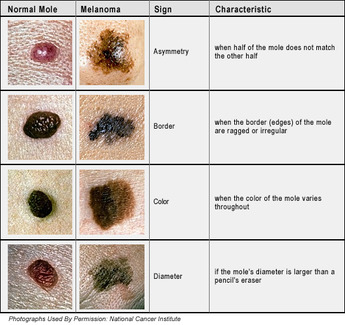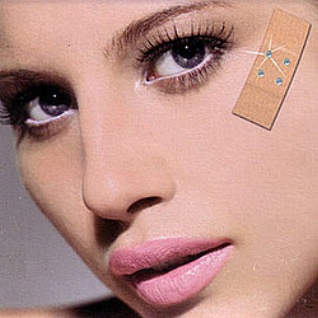What is a facial skin lesion?
A facial skin lesion could be a lump, crack, ulcer or abnormal discoloration of the skin that is not normally present. A lesion is described as benign when it is harmless. It is described as malignant when it is a sign of cancer and is potentially dangerous.The majority of these lesions are benign but some could be malignant. Benign skin lesions may be unsightly or may be traumatized repeatedly especially during shaving. You should seek medical advice if you notice changes in a facial skin lesion, for example: Recent increase in size; Ulceration; Bleeding; Change in colour.


What are the commonest types of benign skin lesions?
Naevi is a medical term for skin moles. They are often darker than the surrounding skin (e.g. brown or brown-black) because they contain more pigment (colour). Rarely, some moles can develop into malignant melanoma especially when they are exposed to a lot of sun.
Capillary haemangiomas (also called strawberry birthmarks). Some grow larger or smaller as the baby/child develops. They are pink or red-purple in colour because they consist of enlarged blood vessels.
Papillomas are wart-like benign skin swellings.
Seborrhoeic keratosis is also known as senile keratosis because it usually occurs in older people. seen in the more senior patients. They appear as yellowish or brown raised lumps.
Fibromas of the skin are raised swellings that are seen in association with chronic trauma.
What are the commonest types of malignant facial skin lesions?
Basal cell carcinoma is the commonest skin cancer and usually occurs as a result of sun damage. These lesions grow slowly and do not spread to other parts of the body. Early tumours appear as translucent, pearly nodules and eventually turn into an ulcer. It is often known as a 'rodent ulcer'
Squamous cell carcinoma can arise in sun damaged skin or normal skin. It shows up as an ulcer. It tends to be localized but some may spread to local lymph nodes, making it potentially dangerous.
Malignant melanoma is a cancer that begins in the pigmented cell in the skin. They are often brown or black. It can spread to other parts of the body. Melanoma is much less common than basal cell and squamous cell skin cancers, but it is far more serious.

What is the treatment for facial skin lesions?
The exact treatment will depend on the place and size of the lesion, the age of the patient, cosmetic considerations, the doctor's recommendations and the patient's preferences. Several treatment options exist. The commonest methods are:
- · Surgical excision: the wound can be stitched together or covered with a flap of skin.
- · Curettage: scraping of the ulcer and allowing the wound to heal itself.
- · Cryotherapy: freezing of the ulcer using liquid nitrogen and allowing the wound to heal itself.
- · Radiotherapy could be helpful in certain malignant skin lesions.
The surgical removal of a skin lesion
The majority of patients will have their operation done under local anaesthestic as a day case. It means that only the area surrounding the lesion is made numb (anaesthetised) so that you do not feel any pain during surgery. You remain awake during the whole procedure. General anaesthesia can be used in children or in very anxious patients. The surgeon may remove a slightly wider area of skin surrounding the lesion to make sure that that none is left behind.
What happens after the operation?
The surgeon may put a dressing over the stitches or leave it uncovered, depending on the site of surgery. Try to keep the area dry for first 24 hrs after the operation. You can take a shower but gently pat the area dry.
There will be some mild pain and discomfort once the local anaesthetic wears off. There will be some swelling or bruising in the first few days but that usually settles down. Please take the painkillers you normally use or the ones prescribed by the doctor. Severe pain is not expected after this type of surgery.
In most cases, you are expected to go home within two hours of the operation and return to work the next day. You should leave a dressing on the wound if you work in dusty or dirty environment.

What will the scar be like?
The scar remains noticeable for the first 3 to 6 months and then starts getting flatter and paler. Massaging the scar with a moisturizing cream two or three times a day in the first few months helps in this process. The scar should be protected from direct exposure to sun during this early period.

Possible complications
Bleeding from the wound is uncommon. If you have any bleeding it can usually be stopped by applying pressure over the area for 5 minutes using a clean dressing. If it does not stop after few attempts you should seek medical advice. Infection is also uncommon. Your surgeon will give an antibiotic ointment or tablets if he or she thinks that infection is expected following the operation.
Will I need further appointments?
You will need to have the stitches removed from the wound 5 to 7 days after the operation. The surgeon will let you know whether you will have your stitches removed at your GP's surgery or at the hospital. The surgeon may send the skin lesion to the pathology department for further examination. It takes up to two weeks to get the report. Your surgeon will write to you once the result is available and advise whether any future follow up appointments will be required.
Is there any alternative treatment?
For selected benign lesions, curettage or cryosurgery (freezing) may be used as an alternative to surgery. This may involve several sessions of treatment for a single lesion. For malignant lesions, surgical excision is the best course of action to remove the lesion and enable examination of the lesion tissue. Radiotherapy may be considered in selected cases.
Disclaimer
The details in this section are for general information only. Always check with your own doctor.